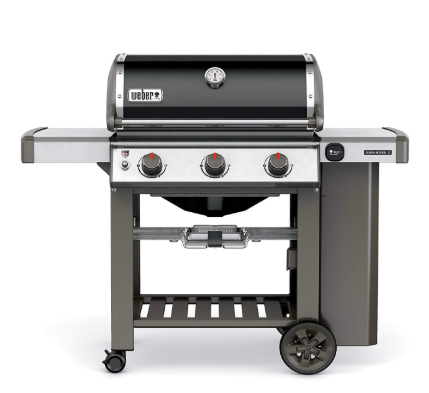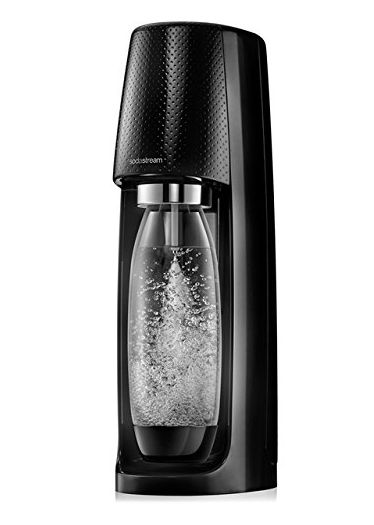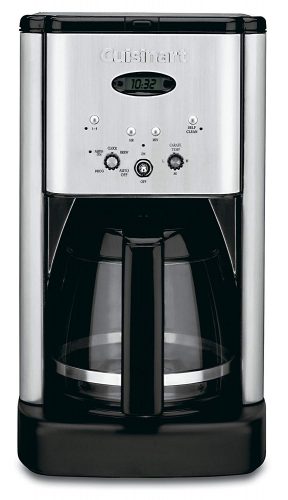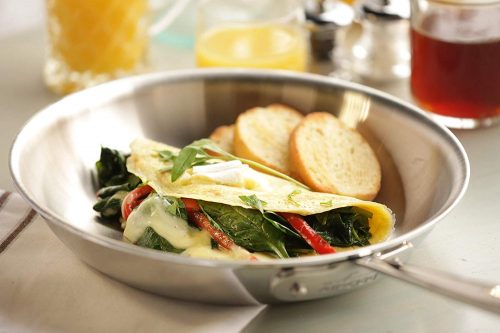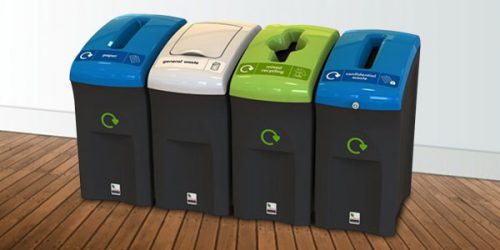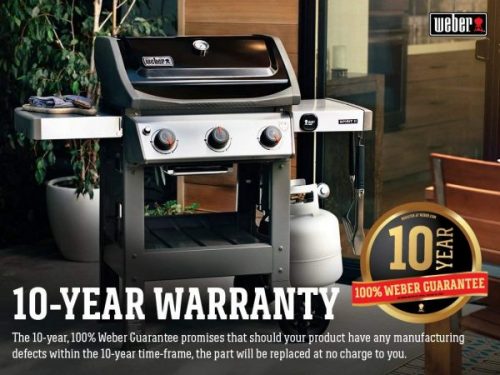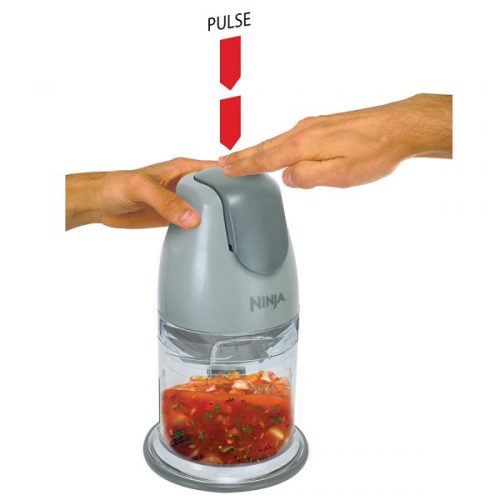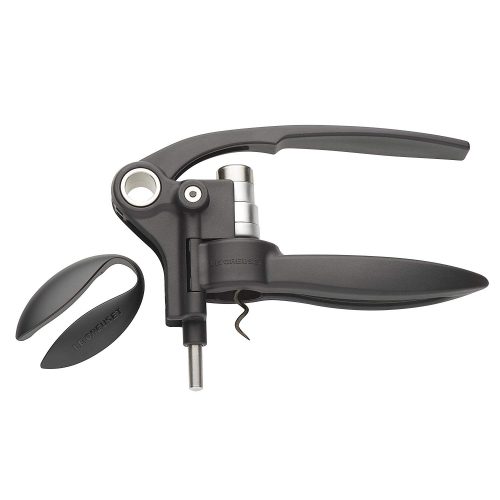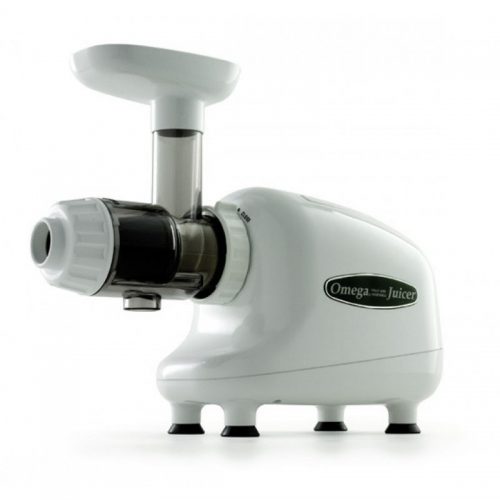
It’s not a cure-all by any means and we still have to eat right and exercise, but juicing is probably the best thing to happen to my health, in a long time.
And I’m far from alone in that opinion. Because I attach such importance to it, I’ve done weeks of research on juicers and I’ll go with the Omega 8003.
It’s more efficient at squeezing nutrients and liquid from leafy greens than the more popular (and admittedly great) Breville juicers. Compared to the Brevilles, some juice experts say you’ll get nearly double the juice from the Omega. And why would you go to the trouble of spending money on fresh produce only to leave half of it behind? At $230, the Omega costs slightly more than low-end juicers, but it offers better quality and taste, it’s is easy to clean and it’s built to last a decade.
(This is still a lot of money for something that may not be part of your life in the long run, so I have a budget recommendation below. That might be a safer bet if you haven’t tried juicing before or aren’t sure if you’re going to be juicing regularly.)
But before I tell you more about the Omega, lets talk about juice. The first time I kicked back a glass of green vegetable juice, I was in Santa Monica, California with my brother. I got high.
It wasn’t the kind of buzz you get from caffeine, or the rush I’d get as a kid from eating an entire bag of skittles. It wasn’t as dulling as marijuana or as debilitating as being drunk. I felt energized from the mix of kale, celery, lemon and cucumber in a way that my professional juice maker Ben Gulick from Juicetoyou would later describe as “the opposite of a food coma.” Ben says when you juice, you feel like you’re mainlining nutrients because your body doesn’t have to work as hard to break them down. Just as when you drink a soda or fruit juice, green juice can go straight to your head. But instead of being loaded with sugar, a single glass of green juice can contain the nutrients of a ridiculous amount of vegetables. To get high on something that is good for you is a unique experience that, for me, is without parallel.
Juicing is sort of like healthy fast food. (When I talk about juicing, I’m talking about the green stuff, mostly. Juicing with too much fruit misses the point. You want the nutrients found in leafy greens like kale, not copious amounts of sugar–which, without fiber holding it back, gets into your bloodstream a little too fast, according to nutritionist Darya Pino from Summer Tomato. I might toss an apple into my kale juice to make it taste a little sweeter, but that’s about it.) After that first glass, I became an addict. I started getting juices at my local hippie cafe, and then I started getting Ben to deliver it by the gallon to my house every week.
Why would I do this? Wikipedia says, “Juicing proponents claim that juicing can maximize nutrient intake, fight disease, strengthen cellular defense against free radicals, alleviate pain, encourage weight loss and decrease the need for medication.” I am a skeptic, and so I don’t believe everything I read about juice. I mean, you still have to eat vegetables. Even so, some doctors from the Mayo Clinic put a damper on a lot of that enthusiam: “Juicing probably is not any healthier than eating whole fruits and vegetables. Juicing extracts the juice from fresh fruits or vegetables…. However, whole fruits and vegetables also have healthy fiber, which is lost during most juicing.” But the Mayo clinic doctors also say, “The resulting liquid contains most of the vitamins, minerals and plant chemicals (phytonutrients) found in the whole fruit.” And without the pulp, the volume in which those nutrients exist is both less and easier to digest.
I asked Ben how much salad equivalent goes into one pint of his green juice, wellness wonder. He said, “at least three handfuls of spinach, a small heart of romaine, half a head of celery, headful of sunflower sprouts, half a bunch of kale. and two lemons, two cucumbers. About.”
I might be able to eat that much raw green at one sittingonce or twice a week. But every day? No way. But getting the equivalent nutrients by drinking a pint of green juice really quickly is no problem. And this is the unarguable truth about juicing: It makes getting the equivalent of vegatables as simple as downing a beer. It’s not as much fun, but it’s more fun than eating three giant salads every day.
My addiction grew. And then I went on a 3 day juice cleanse, to purge myself of the bad stuff.
The first day left me feeling crazy and grumpy, and all I wanted to do was find food. My mouth felt dry and gross. But by the second day, weird stuff started happening. I endured alternating flashes of euphoria and weakness, but also lost a stuffy nose that I’d had for months. I emerged from the cleanse quivering, and ate a donut. But that was just a momentary lapse; I’ve been pretty steady on the juice ever since. I didn’t lose weight or get too extreme about juicing after that, but I reset my sensitivity to sugar, fat and junk, meaning I need less of it to feel happy after a meal. I also quit milkshaking every day, and somehow I am OK with that.
Now, before explaining why the Omega is great, I need to start with the king of all juicers. The ultimate machine, which my local delivery guy from Juicetoyou.net uses, is a Norwalk machine that uses a two-step process to break down and then hydraulically press out juice. Juice from machines like this do not heat or whip up the veggies, and the theory goes that fewer nutrients are broken down as a result. Also, by moving slower and with fewer whipping parts like a centrifugal juicer, oxygen isn’t introduced into the juice. This helps juice last longer. But the Norwalk is a $2,000 machine. It’s meant for pros only.
It’s generally agreed that the Green Star machines, which hover just under $500 and use twin gears to slowly crush vegetables, are the next best thing for vegetables in general. I still think the price tag is too much for a juicer, considering all of us are at risk of buying a juicer and letting it collect dust. Green Star juicers also are specifically meant for veggies; they suck at doing fruit. In fact, you need to get a juice attachment to use them with fruit at all. So they lack versatility. And they’re hard to clean. Which is why the Omega–which can do fruit and is amazing at leafy greens—is a better buy than the Green Star at half the price. It has an auger system, essentially a screw that forces produce into a tight chamber. Like the Green Star, it also makes high quality juice because it is slow–its motor spins at 80 rpm while some centrifugal blenders go at over 10,000 rpm. The Omega is also quiet and easy to clean–it takes about 90 seconds according to this video. And it can do wheat grass as well as extrude pasta, nut butters, grind or make babyfood, which most other juicers like the Brevilles can not.
The Omega 8003 is not perfect, though, because nothing is. It’s not the ultimate choice for doing fruits or hard root veggies, although it can handle those jobs (unlike the Green Star). It takes up more counter space than vertically oriented blenders and, again, isn’t the best at doing hard stuff like carrots and apples or large juicy things like kiwis and tomatoes. It also needs to be manually fed produce and the feed mouth is a little small, meaning you have to cut stuff up before placing it in. The wide-mouthed Breville and the Omega VRT (more on these later) have wider mouths and make the juice more quickly. But, all things considered, I’ll still take the 8003. Results are what counts and it makes astoundingly high-quality green juice from leafy greens and is capable with all other things. You might say that it’s a leafy master and a jack-of-all-trades in other regards. It also has a 10-year warranty. Ten years!
It took three months of research to arrive at this choice. But I had a lot of help, too, especially from John Kohler, the most knowledgeable juicer I could find. He’s been juicing for 25 years and has created over 260 youtube videos comparing and talking about juicers and juicing. He started juicing seriously in his twenties after a doctor said his health was so poor he was in danger of dying. It might raise some eyebrows that I put so much trust in a guy who runs a juicing store at DiscountJuicers.com, rather than seeking out a more traditional, objective editorial viewpoint. But I do trust him. His understanding of juicers is so sophisticated that he refuses to name a best, and his observations and criticisms seem more valid than most editorial sites I’ve visited. He also stocks all brands of juicers, so there’s nothing in it for him to be playing favorites. He is perhaps the most knowledgable person on the internet when it comes to juice. And he likes the Omega 8003 a lot. In any case, Kohler says that for people looking for a juicer that does well with leafy greens at a decent price, the Omega series is hard to beat. He ranks the juice quality and volume of extraction as very high, and with leafy greens, better than that of the Green Star. That tallies with Mike at JuicerBest.com, who ranks the 8003 the top model for veggies. So does BestJuiceExtractorreviews.com, and so do the knowledgable juicers writing Amazon’s reviews, most of whom have experience with Breville and other kinds of juicers. People love the Omega.
The Omega 8003 and its close relatives are simply is the best at dark green leafy veggies, which have the densest nutrient payload of almost any food. Again, it’s the Omega’s slow, methodical rendering that makes the qualitative difference. People who prefer centrifugal juicers don’t seem to grasp that reality. So, why the 8003 and not other Omega models? The Omega 8003 is flanked by the 8005, which has a chrome finish. The 8004 and 8006 are the respective upgrades to those models, and each comes with a 15-year warranty and augers that are eight times as hard. They’re simply not worth the extra money, in my opinion.
Let’s talk about the Omega VRT series, which was designed as the successor to the 800x series above. The Omega VRT juicers have a vertical auger which feeds a little more easily, but costs over a hundred dollars more and isn’t as quite as good at greens even if it’s a little better at soft fruit and almond milk and coconut milk. The thing about the Omega VRT 350HD — the model with a harder screen that won’t crack– is that it has a wider feed mouth so it’s easier to load. Is that worth paying $380 for? I don’t think so but if you can afford it, this thing is killer.
The quality on the Omega VRT series is comparable to the 8003 and the feed mouth makes juicing a bit more convenient. But an extra 40 percent is a lot to pay when the 8003 can do essentially the same job just as well. John from discountjuicers.com uses both the horizontal and vertical Omega juicers for his personal machines, depending on what he’s juicing. He says if you decide to do more than 60 percent fruit, you should go with the vertical mouth. But he’s quick to add that he believes fruit is better blended than juiced, thus backing up my argument for the horizontal 8003, the ultimate leafy green machine.)
The Omega VRT is similar to the Hurom Juicer (same design/factory) that Bon Appetit likes, but it only has a 1 year warranty on parts (10 on motor, but still) so I can’t recommend it. It’s the same thing as the Omega VRT. Compare it in photos, seriously.
What about Breville? Breville juicers are ranked high by a lot of people, including Consumer Reports. A cheaper Breville was even featured in the excellent documentary, Sick, Fat and Nearly Dead, which is about a man named Joe Cross who cured a chronic skin disease by doing a 60-day juice fast. I interviewed Cross about his choice of juicer, which he used with both fruits and veggies in his movie. He said, “The Juice Fountain Plus model (which was less than $250) traveled with me across America for those two months and was both easy to use and dependable. Since then, I’ve become much more aware of the incredible array of juicers at different price points across the market. I look for a number of features – a strong motor, easy cleaning (a separate pulp basket is key for me) and something that sits very solidly.” Now the Brevilles aren’t bad. Clearly, if they work for Joe, they get the job done. The Breville’s are centifugal juicers, which spin very fast to extract juice from contents. They also have a very big input hole so you don’t have to chop produce before dropping it in. They’re dishwasher safe. But they just wouldn’t be my top choice, considering the Omega surpasses it in every way that is meaningful to me. The Breville’s high-speed motor can produce juice much faster than masticating (crushing) juicers like the Omega. That’s why Consumer Reports liked the Breville, ranking it third, even though the Omegas and Green Stars were not considered. But CR failed to consider how the faster process affects taste and nutritional value–they literally did not understand that the quality of juice is affected by the heat and the frothing and the speed. The Breville ranked highly simply because it’s convenient. This is kind of bullshit because you can’t test something without understanding the context in which it is used. People really do notice the difference in taste. One Amazon reviewer prefered the Omega to the Breville, because “cold-press juicers do yield a more stable and flavorful juice.” And another, who tested the 200 series Breville and the Omega 8003, put it like this: “The first time I tried the juice that I got out of my mixture, I was really surprised; the [Omega’s] juice was much more flavorful than the Breville made, and with significantly less thickness/pulp.” The Breville, incidentally, comes with only a one-year warranty. It should also be remembered that the Breville is not optimized for leafy greens like the Omega is. John from discountjuicers.com says that even though the Breville juicers are good and can extract 20 percent more juice than the Omega from hard things like carrots and apples, the Breville juicers can leave behind up to 50 percent of the green leafy juice you would get from an Omega. Half! But before I go on, let me be honest. I still haven’t decided to switch to using a juicer. I might keep getting my juice made by others. Or … maybe not.
On the one hand, juices cost about $5-10 a serving at cafes, or when you get them home delivered, but often they have $3 to $5 dollars of vegatables in them alone. A juicer only starts saving you money after you do a one- or two-hundred servings, which, even for a dedicated juicer could take the better part of a year. And then you still have to take the time to find good produce and dispose of the pulp. In terms of money, it’s kind of a wash. On the other hand, when you juice at home, you have control over the kinds of juice you make and you can ingest it right away, which affects nutrient payload.
How about blenders? I’ve also considered just drinking smoothies, which are easier to make because you’re just tossing stuff together. True, you’re getting all the fiber you’d lose in juicing, but keeping all that fiber brings you back to the same volume of green material that you’d get by eating a salad. Would you rather drink a glass of carrot juice or eat two pounds of carrots? Anyhow, it’s neither good nor bad to blend–it’s just not the same as juicing.
But whoever makes my juice, I would argue that if happiness is the best personal metric, and health is important to happiness, then a machine that makes juice could be one of the most important pieces of gear in my life. Just now, my Omega arrived and so did my delivery of pre-made juice from Ben. I gulped down a glass of fresh kale juice and chased it with a sophisticated cocktail from Juice to You. And I got high.
Budget or Last Year’s Model: If you’re not sure about juicing, don’t get the Omega. Try out the Lequip Mini Model 110 which has a 10-year warranty and metal parts–unheard of for a $100 juicer. Check out this incredible page from John at discountjuicers, breaking down all the budget blenders. (He left off Breville’s budget model because it doesn’t eject, meaning you have to stop half way through each session to manually remove the pulp.) The Lequip won’t make juice as good as the Omega, but it will get the job done and has a smaller footprint. I might get one for my van.


